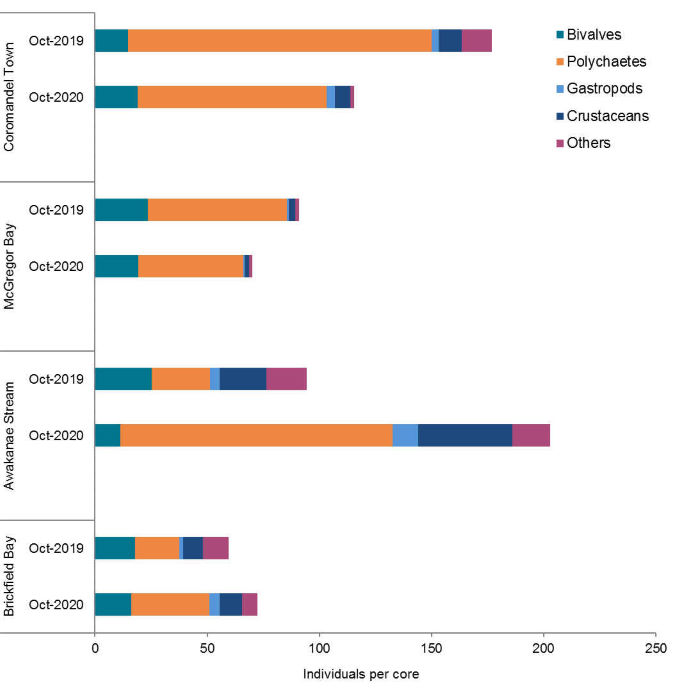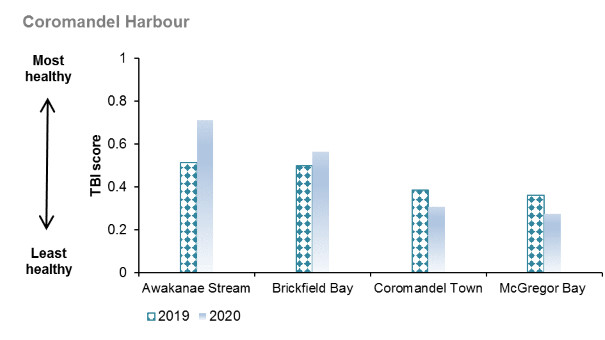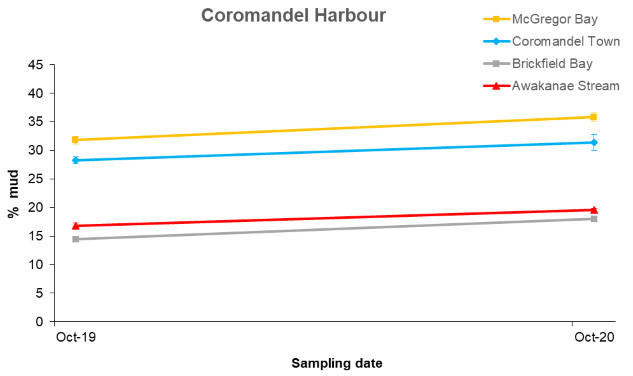Coromandel Harbour
Sediment-dwelling organisms
In Coromandel Harbour the composition of the sediment-dwelling organism community is relatively consistent at each site, whereas the total abundance of individuals each year varies at some sites. In particular at Coromandel Town and Awakanae Stream. Polychaetes are the major component of the sediment-dwelling organism community. Bivalves are relatively abundant at all sites, with other taxa and crustaceans being relatively abundant at Awakanae Stream and Brickfield Bay. Gastropods are generally found in low numbers in Coromandel Harbour.
The two northern sites, McGregor Bay and Coromandel Town have similar compositions of sediment-dwelling organism groups. Polychaetes (Prionospio aucklandica and capitellids) are most abundant, followed by bivalves (cockles - Austrovenus stutchburyi). The number of sediment-dwelling organisms is higher at the Coromandel Town site.
The two southern sites, Brickfield Bay and Awakanae Stream are made up of a broader range of taxa groups compared to the northern sites. Polychates (Prionospio aucklandica and capitellids) and bivalves (Arthritica bifurca and cockles) are the most abundant, with crustaceans (amphipods and crabs) and other taxa (oligochaetes) being relatively abundant. At Awakanae Stream the total abundance of individuals doubled from 2019 to 2020. This was mainly from a big increase in abundance of polychaetes (Prionospio aucklandica and capitellids). At Brickfield Bay, the abundance of sediment-dwelling organisms is consistent and lowest of the four monitoring sites in Coromandel Harbour.
A detailed analysis of all trends in our results as well as the relationships between sediment properties and sediment-dwelling communities are investigated in our latest trend report.

Estuarine health indicator
An estuarine health index called the Traits Based Index (TBI) is used to track the health of our estuary sites over time, and to compare the health of different estuaries. It ranges between zero and one, with one being most healthy and zero being least healthy. The TBI is calculated based on the presence of different species or organisms at a site and uses biological traits (e.g. body size, mobility, feeding behaviour). TBI scores in Coromandel Harbour ranged between 0.3 and 0.7 (moderately healthy) and differed between northern and southern sites. McGregor Bay and Coromandel Town were the least healthy (with average TBI score 0.3), and the southern sites Brickfield Bay and Awakanae Stream were the most healthy (with average TBI score 0.5 and 0.6 respectively).
More detailed information on the TBI can be found on the coastal biology indicator webpage.

Sediment properties
We measure sediment properties (including total organic carbon, total nitrogen, chlorophyll a, phaeophytin and grain size) at our monitoring sites and investigate if they are changing over time. Changes could indicate responses to mechanical disturbance, changes to water quality or the introduction of terrestrial sediment and contaminants. One important property we measure is grain size. If the intertidal flats are exposed to increasing sediment run-off from the catchment or other sources of fine sediment, the proportion of smaller grain sizes such as mud increases. This can create an unsuitable habitat for some sediment-dwelling animals.
The graph below shows the average (± standard error) sediment mud content (%) at each monitoring site between 2019 and 2020. The standard error is a measure of how accurate the average is. In Coromandel Harbour the mud content was highest at the two northern sites, McGregor Bay and Coromandel Town (average 30-34%) and lowest at the two southern sites, Brickfield Bay and Awakanae Stream (average 16-18%). The mud content was relatively consistent between 2019 and 2020.
A full analysis of grain size and other sediment properties can be found in our latest trend report.



To ask for help or report a problem, contact us
Tell us how we can improve the information on this page. (optional)